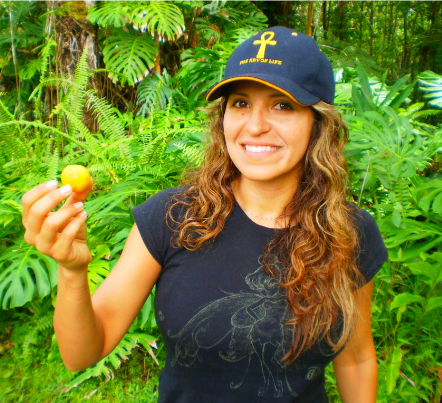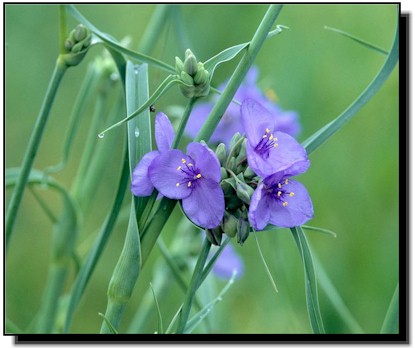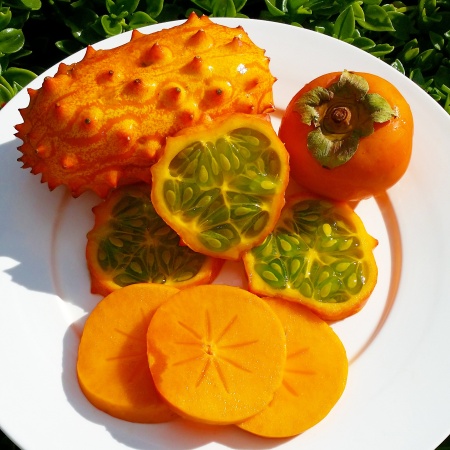Pocahontas had to learn how to collect wild edible plants along with planting and harvesting vegetable crops, in order to be considered an adult woman. As a result, she would need to identify the various kinds of useful plants, fruits and vegetables, and have the ability to recognize them in all seasons. Pocahontas learned these survival skills by age of 13.
Pocahontas also helped ease starvation and illness among Jamestown Colonists by teaching them how and what foods to eat. By my accounts, that makes Pocahontas America’s first Nutritionist.
If you were in the wild, would you know some of the edible wild plants and fruits? Some of the foods Pocahontas ate are the Virginia peas, Corn, Pumpkins, Crooked neck Squash, Putchamins (Persimmon), Paw Paw fruit, and Gamma Rays (spider wort).
While on a hike in Kauai, I quickly learned that I was far from Pocahontas material and had to learn more about wild plants and survival foods. My hiking partner and I took a wrong turn, got lost and had to spend the night in the pouring rain in a remote area. We had no cell phone service, no rain gear and we quickly ran out of water. Fortunately, I was familiar with the wild Guava and had collected some for nourishment during our day hike. It was an unforgettable adventure, but also a painfully cold and enlightening experience.
Most of us are familiar with the Persimmon, Crooked neck squash, Pumpkins and Peas, so I’m sharing more information about some of the less known edible plants and fruits like the Spiderwort.
Spiderwort plants and flowers grow in clusters, with each individual bloom lasting only part of a day. All parts of many Spiderwort can be eaten- leaves, flowers, stalks and roots.The spiderwort (Tradescantia ohiensis) also has medicinal properties. The plant’s crushed leaves are purported to alleviate the sting of insect bites and when in tea form, it can be used for kidney and stomach pain, as a laxative and increasing breast milk.
Some other edible wild plants are Amaranth, Burdock, Cattail, Clovers, Nasturtium, Chickweed, Dandelion and Chicory. You will love this Nasturtium Blossom Salad. Nasturtiums can be used as an antibiotic for bronchitis, sore throat, flu, etc…
The Paw Paw fruit is not very well known among the mainstream, but people have enjoyed the vast health benefits for at least 500 years. The Paw Paw has a smooth, custard-like texture and a subtle but excellent strawberry-banana type flavor. The Paw Paw fruit is not only the largest fruit native to North America, it also brings with it a wide range of unbelievable health benefits and is called the “newly discovered superfood”, despite its long history of use. It has 70 times the Iron as many fruits, has high levels of antioxidants, 20 times the Magnesium of apples/bananas and more Vitamin C than Oranges.
Other fruits not well known to some North Americans are the Cactus Pear Fruit and the Horned Melon Fruit. Cactus Pear Fruit or Prickly pear cactus, also called Nopales, is promoted for treating diabetes, high cholesterol, obesity and hangovers. It is also ued for its antiviral and anti-inflammatory properties and is popular in Latin America. The edible parts of prickly pear cactus are the leaves, flowers, stems and fruit. Prickly pear cactus are found in all of the deserts of the American Southwest. Most prickly pears have large spines on their stems and vary in height.
Although I have heard so many stories about the prickly pear cactus fruit and it’s defense mechanisms to protect it’s fruit, I truly did not grasp how dangerous it is to collect this delicious fruit. It was one of the most painful lessons I ever had to learn while hiking in Oracle, Arizona. Let me just say that pliers were used to remove the needles from my hand. If you are stranded and need to eat this, please take great care when collecting the cactus fruit… Yummy but Ouchy!
Native to the Kalahari Desert in Africa, the Kiwano is also known as the Horned Melon, the melano, the African horned cucumber, the jelly melon, and hedged gourd. When ripe, the fruit tastes like a mix of cucumbers, kiwis, honey dew and bananas. During the dry season, the Horned Melon is the only source of water in the African desert and may help save your life. The horned melon is really an unusual looking fruit. It has a nearly ancient physical appearance and is now grown in Australia and New Zealand. This melon contains high levels of Vitamin A and organic types of vitamin E tocopherols.
There are so many fruits and wild plants to share, but I will share one more called the Loquat.
There was a massive gas line leak in our neighborhood and my toddler and I had seconds to unexpectedly evacuate. It was 107 degrees outside and my husband was stuck in traffic rushing to get home to us. We wandered to a local neighborhood exploring and made the best of our situation. We discovered a tree with a succulent, tangy and yummy fruit called Loquat.
Loquat fruit is rich in vitamins, minerals, and anti-oxidants. This unique fruit originated in the wild mountainous, evergreen rain forests of Southeastern China, but has now spread all across the world, including Japan.
If you can not clearly identify a plant and you are unsure about whether it is poisonous, it is best you don’t eat it. Some common toxic plant signs are: three leaved growth pattern, grain heads with pink, purplish or black spurs, almond scent in the woody parts and leaves, bitter or soapy tasting plants, beans, bulbs or seeds inside pods, spines or thorns, milky or discolored sap. (Brett & Kate McKay, surviving in the Wild).
 I hope this article has inspired you to get to know the terrain you plan to explore or the terrain local to you in case of an emergency. If you are already well versed in the area of wild plants and fruits, maybe there are children, a community or people you can be a Pocahontas for!
I hope this article has inspired you to get to know the terrain you plan to explore or the terrain local to you in case of an emergency. If you are already well versed in the area of wild plants and fruits, maybe there are children, a community or people you can be a Pocahontas for!
*This picture is used to embrace my Native American Heritage.
Stay healthy & happy, ~Dr. Dee
















2 thoughts on “Edible Plants & Fruits that Help You Survive The Wild”